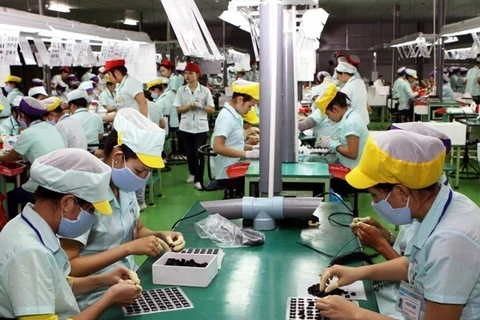Hanoi (VNA) - Nearly 5 million workers in the textile, electronics and retail sectors will be affected by the technology movement, according to a survey by the Chamber of Commerce and Industry of Vietnam (VCCI) on labour market trends.
This is one of the major downsides of the technological revolution that has for many years also greatly benefited people and economies, Tin Tuc (News) reports.
To ensure jobs, not only the State and enterprises, but also the workers themselves have to improve their skills to adapt.
Dao Thi Thu Hien, Chief of Canon Vietnam Office, said seven years ago, Canon Thang Long Plant in Dong Anh district employed 13,000 workers, but the number had dropped to 8,000 with automation, while turnover and production remain stable.
With robots and computing advancements replacing workers, especially those performing repetitive tasks, low-skilled workers are the most harmed, according to Hien.
Deputy General Director of the Garment No.10 Corporation, Nguyen Thien Ly, said: "The trend of using technology to replace human labour is indispensable in order to reduce costs and compete.”
In recent years, the company had to invest in equipment to cut labour costs, she said. For example, an automatic cutting machine could replace 12-15 employees, said Ly. "Over the past year, the garment industry faced difficulties due to the increase of labor costs in Viet Nam while there were fewer preferential tax policies so application of new technologies replacing labour will partly help solve this difficulty," she said.
According to a survey by the World Labour Organisation (ILO), to meet the trend of integration, some foreign-invested garment factories in Vietnam put advanced technology in use last year to replace 10 to 15 workers in each stage of production.
In the coming years, 86 per cent of Vietnamese workers are at high risk of losing their jobs to automation, according to the ILO’s study. Robots will replace three-quarters of the workers in the electricity and electronic industries, the study said.
"This requires Vietnam to develop a comprehensive and synchronous strategy," said Vu Tien Loc, Chairman of VCCI.
Dao Van Vinh, Director of the Institute of Labour and Social Sciences under the Ministry of Labour, Invalids and Social Affairs (MOLISA), said globalisation and the scientific and technological revolution are posing challenges for the labour market.
Over 11.2 million out of more than 54 million workers in the country had undergone training and gotten diplomas and certificates, he said. But the number of workers trained in engineering and technology remained low, he added.
"And the country still lacks skilled workers in mechanical engineering, electronics, electrical engineering as well as corporate governance, finance, banking, information technology and automation, "Vinh said.
According to statistics of the Vietnam National Productivity Institute, the Vietnamese are assessed to be hard working and dedicated labourers, but labour productivity remains lower than in other ASEAN bloc countries.
Vietnam would take many more decades to catch up with them as well as with other advanced countries in the world, Vinh said.
A survey by the Institute of Labour Science and Social Affairs has pointed out that 50 per cent of firms don’t forecast which skills are needed in the future, and 38 per cent don’t have close link with vocational schools or other training facilities.
According to Ly, most employees have to be retrained when they are recruited. Enterprises are looking forward to State support in training qualified workers.
Loc said the working environment at enterprises was a good school and enterprises should actively participate in the training process to meet the demand of the labour market.-VNA
This is one of the major downsides of the technological revolution that has for many years also greatly benefited people and economies, Tin Tuc (News) reports.
To ensure jobs, not only the State and enterprises, but also the workers themselves have to improve their skills to adapt.
Dao Thi Thu Hien, Chief of Canon Vietnam Office, said seven years ago, Canon Thang Long Plant in Dong Anh district employed 13,000 workers, but the number had dropped to 8,000 with automation, while turnover and production remain stable.
With robots and computing advancements replacing workers, especially those performing repetitive tasks, low-skilled workers are the most harmed, according to Hien.
Deputy General Director of the Garment No.10 Corporation, Nguyen Thien Ly, said: "The trend of using technology to replace human labour is indispensable in order to reduce costs and compete.”
In recent years, the company had to invest in equipment to cut labour costs, she said. For example, an automatic cutting machine could replace 12-15 employees, said Ly. "Over the past year, the garment industry faced difficulties due to the increase of labor costs in Viet Nam while there were fewer preferential tax policies so application of new technologies replacing labour will partly help solve this difficulty," she said.
According to a survey by the World Labour Organisation (ILO), to meet the trend of integration, some foreign-invested garment factories in Vietnam put advanced technology in use last year to replace 10 to 15 workers in each stage of production.
In the coming years, 86 per cent of Vietnamese workers are at high risk of losing their jobs to automation, according to the ILO’s study. Robots will replace three-quarters of the workers in the electricity and electronic industries, the study said.
"This requires Vietnam to develop a comprehensive and synchronous strategy," said Vu Tien Loc, Chairman of VCCI.
Dao Van Vinh, Director of the Institute of Labour and Social Sciences under the Ministry of Labour, Invalids and Social Affairs (MOLISA), said globalisation and the scientific and technological revolution are posing challenges for the labour market.
Over 11.2 million out of more than 54 million workers in the country had undergone training and gotten diplomas and certificates, he said. But the number of workers trained in engineering and technology remained low, he added.
"And the country still lacks skilled workers in mechanical engineering, electronics, electrical engineering as well as corporate governance, finance, banking, information technology and automation, "Vinh said.
According to statistics of the Vietnam National Productivity Institute, the Vietnamese are assessed to be hard working and dedicated labourers, but labour productivity remains lower than in other ASEAN bloc countries.
Vietnam would take many more decades to catch up with them as well as with other advanced countries in the world, Vinh said.
A survey by the Institute of Labour Science and Social Affairs has pointed out that 50 per cent of firms don’t forecast which skills are needed in the future, and 38 per cent don’t have close link with vocational schools or other training facilities.
According to Ly, most employees have to be retrained when they are recruited. Enterprises are looking forward to State support in training qualified workers.
Loc said the working environment at enterprises was a good school and enterprises should actively participate in the training process to meet the demand of the labour market.-VNA
source






















